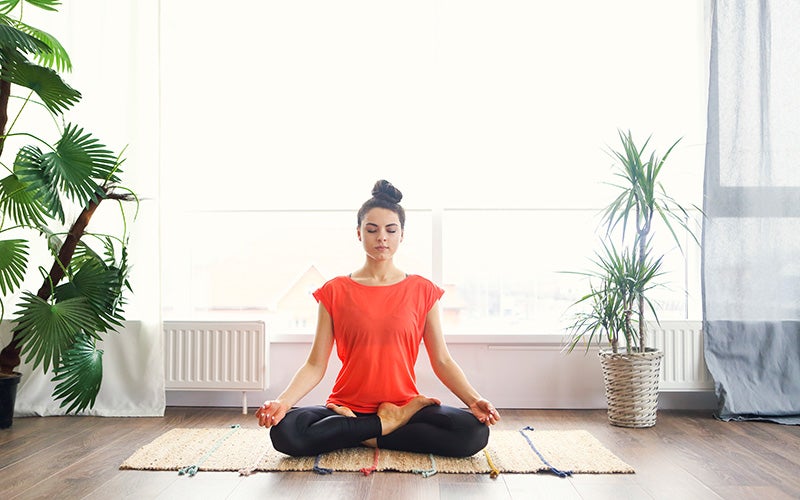Yoga for Beginners: Here’s what to expect from your first session!
 ©petrenkod
©petrenkod
Here we’ll show you what to look out for when you’re just starting with yoga. We have all the information on yoga for beginners, including what to expect before your first class and even some thoughts on YouTube videos so you can start right away!
When you hear the term yoga, what’s the first thing that comes to your mind? Is it people who are knotted up and balancing in the strangest poses? These are advanced yogis who have been practicing yoga for years. You can consider them inspiration or just forget about these images and concentrate on yourself instead.
Yoga is a philosophical teaching from India, which focuses on connecting body, mind, and soul. The yoga exercises on the mat, the so-called asanas, are an integral part of achieving this goal.
Yoga exercises are also a powerful core workout and improve your coordination and flexibility. They also improve your mental state.
As a beginner, you start slowly with simple movements. These will test your flexibility and train your body awareness and the connection between your breath and your movement. The conscious body awareness that you practice in yoga will also benefit you in any other physical activity.
Which yoga styles are suitable for beginners?
Which style is suitable depends on what you want, and all styles have options for newcomers to the practice. Do you want to be mostly quiet and calm? Then Yin Yoga might help. Studios often offer restorative classes as well.
Vinyasa Flow or Power Yoga will really get you sweating. How exactly the individual classes are taught will depend on the teachers and possibly the specific studio.
In most yoga classes, you practice as a group, according to the teacher’s instructions. The asanas and their sequence can vary from week to week. In many Hot Yoga and Ashtanga studios, however, this is not the case. There, you will often practice the same sequence every week.
Regardless of which style you choose, all yoga practices draw from the same repertoire of poses. It’s the type of instruction, pace, and order of the poses that vary.
No one style is generally considered to be more or less suited for those new to yoga. The best thing is to ask yourself what you are generally looking for and then just try it out. Yoga should be fun. Nevertheless, it doesn’t hurt to think outside the box and try something that you think you might not be comfortable with.
Maybe you’ll discover a whole new side of yourself, and it wouldn’t hurt to leave your comfort zone!
Yoga for beginners – What’s the best way to start?
1. Discover your why.
From relaxing Yin Yoga, to spiritual Kundalini, to strenuous Power Yoga, you can find almost every yoga practice imaginable, especially in big cities. Ask yourself why you want to start with yoga and what criteria you are looking for in a yoga class or studio. Find yoga studios that meet these criteria and choose a style that fits your goal.
Find a yoga studio.
The best approach is to find a studio for when you first try it out. This makes sense especially for those new to yoga practice. It’s more fun with others, and under the guidance of a qualified teacher you will practice a sequence that makes sense and matches the needs of the group. If you get stuck, the teacher will help and give you some modifications.
Find your routine.
Sometimes yoga is fun right from the start. But sometimes it isn’t. Logically: The better you can do something, the more fun it is. So if the first lesson wasn’t perfect, don’t just give up. Take your time to become familiar with the movements and to go to classes more regularly. Practicing yoga 2-3 times a week for a month will give you an idea of whether the style, teacher, and studio suit you. If not: try it elsewhere.
4. Stay realistic.
Headstands, lotus seats, and other fancy yoga poses are not for beginners. After all, you don’t get up one day and run a marathon because you always wanted to go running. The chances of this going wrong and you getting hurt are just too high. Ask in the yoga studio which course level is suitable for you and follow their advice.
5. Don’t compare yourself.
Sounds easier than it is. But honestly: why should you compare yourself to someone who has been practicing yoga for years? Or feel superior over other beginners because, thanks to years of ballet, you can do the splits in your sleep? Stay focused and concentrate on your own experience. Just as in other physical activity, every body is different. And that’s a good thing.
6. Take it slow.
When you’re first starting your practice, try it all out in peace and quiet and slowly. Pushing and wanting too much is out of place here. Do a reality check now and then: Do you feel good? Are all your joints in a healthy alignment, so that nothing hurts? Does the position make sense to you? If it does, you might also try the limits of your comfort zone and get a little deeper into the asana.
You should also exercise restraint when eating before yoga: There should be about 3 hours between your last big meal and your yoga class. Drink something warm – it is good for the stomach and the soul. Warm water will do. Tea is much more delicious.
7. Don’t put pressure on yourself.
You are not too weak to lift weights or too slow to run. It might be the case that in the beginning – perhaps even longer – you cannot quite straighten your legs in a downward-facing dog. But that doesn’t matter. Yoga is a perfect flexibility training for beginners.
Just as with strength or endurance training, there is a variation for every exercise that works for your body. Just ask for help from your yoga teacher about what you can do if you encounter any difficulties.
Once the excitement of the first lesson is over and you are familiar with the basic movements, you will notice that, in addition to improving strength and flexibility, yoga also just feels good. While doing yoga there is no hectic rush. You concentrate on your breath & body and create a space where your thoughts come to rest on the essential.
8. Try it out on YouTube.
If you don’t feel like going to the studio and spending 60 or 90 minutes on the mat, but you want to start right away, that’s no problem. You can find a simple flow to practice at home – whether 5, 10 or 50 minutes.
But again, look for something that is specifically designed for yoga beginners. No fancy poses, no fancy transitions, but rather slow and precise.
By the way: Even bending forward or backward can put a lot of strain on your spine and your intervertebral discs if you do it wrong. Beginners at home should be doubly careful: make sure you only do what feels right.
Yoga exercises for beginners
As a beginner we’d recommend you take a closer look at the movements that are found in almost every yoga class and that sometimes build on each other. Even with seemingly easy movements, the finesse is in the detail and it is worthwhile to take a closer look at the technique.
Yoga for beginners: Summary
- The origins of yoga lie in ancient Indian teachings
- The basics of yoga are about connecting body, mind, and soul.
- Yoga movements are called Asanas
- Yoga for beginners means that you listen to yourself and your needs
- Don’t put yourself under any pressure, and try to internalize the yoga basics before you try advanced poses
Sources for this article
We at foodspring use only high-quality sources, including peer-reviewed studies, to support the facts within our articles. Read our editorial policy to learn more about how we fact-check and keep our content accurate, reliable, and trustworthy.

































